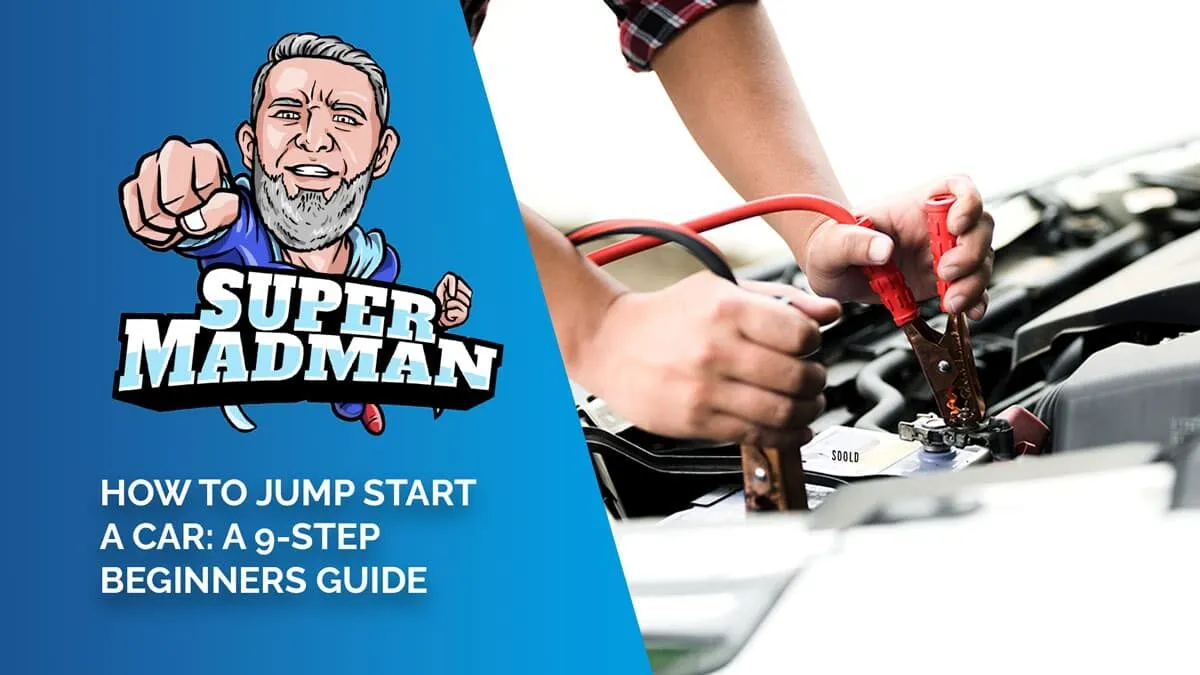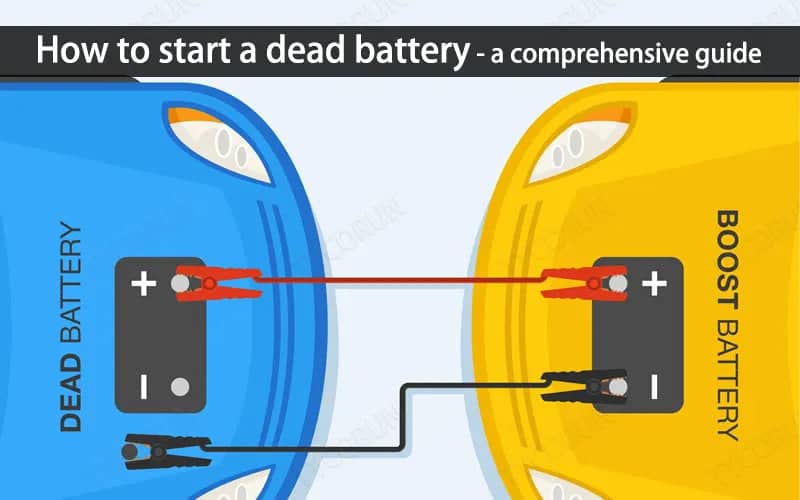To jump a dead battery, you will need jumper cables and a working vehicle. Here is a step-by-step guide to help you jump-start your dead battery.
Is your car refusing to start? One of the common reasons for a stalled car is a dead battery. It can happen when you leave your headlights on overnight or if your battery is aging. But don’t worry, jump-starting a dead battery is a relatively simple process that can get you back on the road quickly.
We will outline the steps to jump a dead battery so that you can be prepared for any unexpected situations on the road.
Understanding Car Batteries
Before you can jump-start a dead battery, it’s essential to have a basic understanding of car batteries. Knowing how they work and what can lead to a dead battery will help you troubleshoot common issues and prevent future problems. In this section, we will explore the signs of a dead battery and the causes behind it.
Signs Of A Dead Battery
Identifying the signs of a dead battery is crucial in determining whether your car’s battery needs a jump-start. Here are a few common indications that your battery may be nearing the end of its life:
- Your engine cranks slowly or doesn’t start at all
- The dashboard lights dim or flicker
- You experience difficulties when starting the car
- Your headlights appear dim or fail to turn on
- The battery warning light on your dashboard illuminates
Causes Of Dead Batteries
Dead batteries can be caused by a variety of factors. Understanding these causes will help you take necessary precautions to prevent battery failure:
- Inactivity: Leaving the car unused for an extended period, especially in cold weather, can drain the battery.
- Aging Battery: Over time, car batteries can degrade and lose their ability to hold a charge.
- Electrical System Issues: Faulty alternators, voltage regulators, or loose connections can lead to battery failure.
- Extreme Temperatures: Exposing the battery to extreme temperatures, whether hot or cold, can shorten its lifespan.
- Leaving Lights On: Accidentally leaving your headlights or interior lights on can rapidly drain the battery.
- Faulty Charging: Malfunctioning charging systems can fail to recharge the battery properly, leading to its demise.
By understanding the signs of a dead battery and the causes behind it, you’ll be better equipped to handle the situation effectively and take necessary preventive measures. Now that you have a solid grasp on car batteries, let’s move on to the next section: How to Jump a Dead Battery.
Preparing To Jump Start
Jump-starting a dead battery is a skill that every driver should know. Whether you’re stranded in a parking lot or helping out a friend, being prepared can save you time and stress. Before you attempt to jump-start a dead battery, it’s important to gather the necessary tools and follow safety precautions to ensure a successful and safe jump start.
Gathering Necessary Tools
Before you begin the jump-start process, make sure you have the following tools on hand:
- Jumper cables: High-quality jumper cables with thick-gauge wires are essential for a successful jump start. Ensure that the cables are long enough to reach from one battery to another without strain.
- Second vehicle: You’ll need a second vehicle with a fully charged battery to provide the necessary power for the jump start. Make sure the vehicle is positioned in a way that allows easy access to both batteries.
Safety Precautions
Jump-starting a dead battery can be potentially hazardous, so it’s crucial to take the following safety precautions:
- Protective gear: Wear safety glasses and gloves to prevent any potential accidents or injuries while handling the battery and jumper cables.
- Turn off the ignition: Ensure that both vehicles are turned off and the ignition keys are removed before starting the jump start process.
- Identify battery terminals: Locate the positive (+) and negative (-) terminals on both batteries. They are usually labeled with a plus and minus sign or red and black covers. It’s essential to identify them correctly to avoid any electrical mishaps.
- Proper connection: Make sure to connect the jumper cables in the correct order: positive to positive and negative to negative. This sequence will minimize the risk of electrical sparks and damage to the vehicle’s electrical systems.
- Stay clear of moving parts: Keep hands, loose clothing, and any other objects clear of the engine compartment, especially while the vehicles are running.
By gathering the necessary tools and following safety precautions, you’ll be well-prepared for a successful jump start without any unnecessary risks. Now that you’re ready, let’s move on to the step-by-step process of jump-starting your dead battery.
Identifying Battery Terminals
Identifying the battery terminals is crucial when it comes to jumping a dead battery. By locating the positive and negative terminals and understanding their colors, you can ensure a safe and successful jump-start. Let’s break down the process step by step.
Locating Positive And Negative Terminals
When you pop the hood of your car, the first step is to locate the battery. In most vehicles, the battery is easily accessible under the hood. You’re looking for two terminals, usually covered with red and black plastic caps. These caps indicate the polarity of the terminals.
Understanding Terminal Colors
The positive terminal is typically marked with a + sign and is covered with a red plastic cap. On the other hand, the negative terminal is marked with a – sign and has a black plastic cap.

Credit: www.amazon.com
Jump Starting The Battery
When your car battery is dead, jump-starting it is a quick and practical solution. Below are the steps to effectively jump-start a dead battery, starting with Connecting Jumper Cables:
Connecting Jumper Cables
1. Park the vehicles close enough so the jumper cables reach but do not touch each other.
2. Turn off both vehicles and locate the battery terminals: red for positive (+) and black for negative (-).
3. Connect one end of the red cable to the dead battery’s positive terminal and the other end to the positive terminal of the working vehicle.
4. Attach one end of the black cable to the working vehicle’s negative terminal and the other end to a metal surface on the dead vehicle.
Starting The Working Vehicle
1. Start the working vehicle’s engine and let it run for a few minutes to charge the dead battery.
2. Attempt to start the dead vehicle; if it does not start, wait a few more minutes and try again.
3. Once the dead vehicle starts, leave it running for at least 10 minutes to allow the battery to recharge.
After Jump Starting
When dealing with a dead car battery, it’s crucial to know how to properly jump start it. To begin, ensure both cars are turned off before connecting the jumper cables. Then, follow the correct sequence to safely revive the dead battery and get back on the road.
To ensure your vehicle stays running smoothly after jump-starting, there are essential steps to take after jump starting.Letting The Engine Run
After jump-starting, leave the engine running for at least 10 minutes. This allows the battery to recharge and ensures it has enough power to continue operating.Testing The Revived Battery
To check if the battery is fully revived, turn off the engine and try to start the vehicle. If it starts without needing another jump, the battery likely has enough charge. When testing the revived battery, it’s crucial to ensure all electrical components such as lights and radio are functioning properly. This indicates that the battery is holding a charge. After confirming the battery’s condition, consider driving the vehicle for at least 20-30 minutes to allow the alternator to fully recharge the battery. These post-jump starting steps are crucial in ensuring the battery is functioning optimally and the vehicle remains reliable on the road.
Credit: www.offroadchampions.com

Credit: www.madmanmotors.com.au
Frequently Asked Questions Of How To Jump A Dead Battery
How Do You Jump A Completely Dead Battery?
To jump a dead battery, follow these steps: 1. Park a fully charged car next to the dead one. 2. Attach the red (positive) jumper cable to the dead battery’s positive terminal. 3. Connect the other red end to the charged battery’s positive terminal.
4. Attach the black (negative) cable to the charged battery’s negative terminal. 5. Connect the other black end to an unpainted metal surface on the dead car. Start the charged car, let it run for a few minutes, then try starting the dead car.
Can A Battery Be Too Dead To Jump?
Yes, a battery can be too dead to jump.
How Do You Jumpstart A Dead Battery Without Another Car?
You can jumpstart a dead battery without another car by using a portable jump starter. Connect the positive and negative clamps to the corresponding battery terminals, then start the vehicle. Ensure the jump starter is fully charged and follow the manufacturer’s instructions for safe use.
How Long Does It Take To Jump Off A Completely Dead Battery?
It typically takes around 15-30 minutes to jump off a completely dead battery.
Conclusion
In a nutshell, understanding how to jump a dead battery is a valuable skill for any driver. By following the proper steps, you can quickly and safely recharge your vehicle and avoid being stranded. With a few tools and some know-how, you’ll be back on the road in no time.
Remember to prioritize safety and follow the instructions closely.
